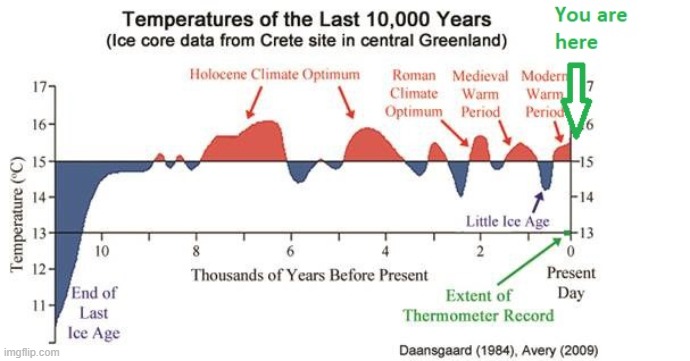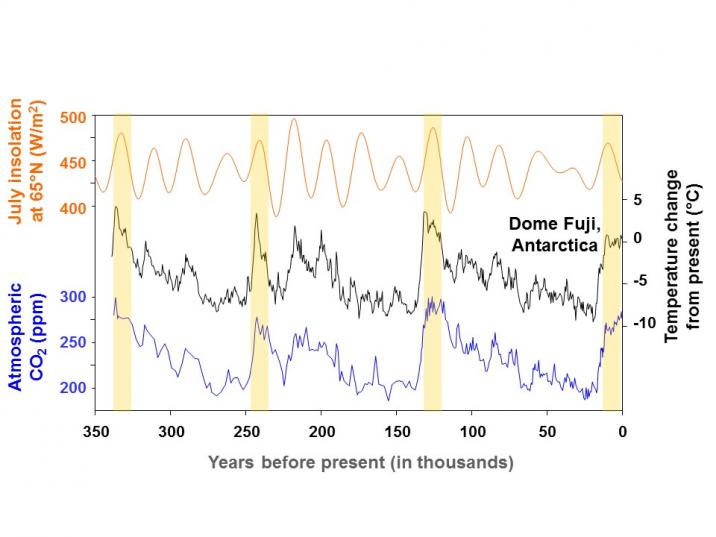Skip to comments.
How the IPCC Buried the Medieval Warm Period - And why it keeps proving today’s warming isn’t unique or unnatural
Irrational Fear ^
| 21 Apr, 2025
| Dr. Matthew Wielicki
Posted on 04/22/2025 6:30:16 AM PDT by MtnClimber
click here to read article
Navigation: use the links below to view more comments.
first 1-20, 21-22 next last
To: MtnClimber
The democRATs don’t care. The climate change movement was never about the climate. It was always an excuse to impose rationing, one of the key elements of communism.
2
posted on
04/22/2025 6:33:58 AM PDT
by
MtnClimber
(For photos of scenery, wildlife and climbing, click on my screen name for my FR home page.)
To: MtnClimber
Thanks for posting.
One of my favorite graphs shows the warming and cooling periods of the last few thousand years.

3
posted on
04/22/2025 6:34:41 AM PDT
by
Tell It Right
(1 Thessalonians 5:21 -- Put everything to the test, hold fast to that which is true.)
To: MtnClimber
Indeed.
This is another aspect which should be pursued by DOJ:
Scientific fraud to both elicit research $$ and rob the treasury.
RICO case could be made easily...if there were some cajones.

4
posted on
04/22/2025 6:34:46 AM PDT
by
logi_cal869
(-cynicus the "concern troll" a/o 10/03/2018 /!i!! &@$%&*(@ -)
To: MtnClimber
Wonder why they named that piece of land “Greenland”?
Because it was GREEN. The Vikings built houses and farmed during their visits.
Weather is cyclical, it changes.
5
posted on
04/22/2025 6:34:51 AM PDT
by
9422WMR
To: MtnClimber
There was an ice age that ended about 11,000 years ago. There were warm periods and cold periods. These cycles continue today and will not end any time soon.
It’s foolish to think that the natural cycles stopped as soon as humans started to burn coal and oil, and that man’s use of fossil fuels is the driving force behind climate change.
To: MtnClimber
What’s the BCG? Baja California Glacier? Bossier City Glacier?
To: Verginius Rufus
Boulder Clay Glacier (BCG) - in Antarctica’s Victoria Land
8
posted on
04/22/2025 6:44:38 AM PDT
by
MtnClimber
(For photos of scenery, wildlife and climbing, click on my screen name for my FR home page.)
To: MtnClimber
Thanks. Antarctica makes better sense than Baja California or Louisiana.
To: MtnClimber
What they fail to mention is that 125K ago, BEFORE the last Ice Age Co2 and temperatures were higher that they have ever been during our current interglacial. And that the "normal" for Earth is COLD by 80% of it's lifetime.

To: MtnClimber
They also buried the depth of the Little Ice Age. I had to go through the accounts of Spanish explorers myself to extract indications of climate along the Pacific Coast during that time, the marine influence there being a superior indicator of change. I sent the quotes to Anthony Watts, but I don't know what else to do with them.
These quotes and extracts are listed as follows on p19 of the Wildergarten Site History:
Cabeza de Vaca survived eating shellfish in Florida in June 1528, a month in which (today) a red tide in the Gulf of Mexico would have rendered shellfish poisonous. Yet there is no record of his group suffering from neurological shellfish toxicity. In December 1602, Sebastian Vizcaino’s voyage landed at Monterey noting snow on the hills above and ice in a pond frozen ‘a hand palm thick’ only a few hundred yards from the Pacific Ocean (although Vizcaino’s reports were of marginal reliability).
Juan Crespí, the highly reliable diarist of the Portolá Expedition, 24 September, 1769 in Jolon, San Antonio Valley, 25 miles northwest of Paso Robles, elevation 800 feet, behind two ridges of coastal mountains inland from Santa Barbara:
It is a very cold spot, with snow and heavy frosts [in September?]. Through the heathens belonging to this spot, we understand that in some years the snow falls a quarter, a half, or three quarters of a yard deep. From the Diary of Gaspar de Portolá amid the Santa Lucia Mountains: Dec. 19 …we travelled for three hours, passing the most difficult part of the range on which there was not a little snow [snip] The 17th [January] we proceeded for about five hours, making [the same distance as] two marches on the previous journey, and came out on the Llano de la Puente, opposite the great sierra of snow-covered [San Gabriel] mountains…
From the 1769 account of the Portolá Expedition Engineer, Miguel Costansó: Thursday, December 7 …in view of the few provisions that remained, the excessive cold, and, above all, the snow that beginning to cover the mountain range - our commander himself resolved upon the return believing that if the passage over the mountains became impossible we should all perish. They were planning to cross mountains in coastal Southern California. Why were they afraid of snow? The Diary notes that the packet San Carlos had supplied the expedition. From the ship’s log of Vicente Vila the prior spring, April 26 to May 1, 1769: At sunrise, I was between four islands [in the Santa Barbara Channel] and the mainland the country high and mountainous with several high ridges extending northwest to southeast, all of them covered with snow, like the Sierras Nevadas [Snowy Mountains] of Granada on the coast between Motril and Salobreña near the Mediterranean. Following the notes of the sea pilot, Cabrera Bueno, I decided that they might be the ridges which the Philippine sailors call Sierras de Santa Lucia above Cape Conceptión [those along the channel are the Santa Ynez Mountains]. [snip]… Turning toward the mainland, I noted the extremity of it visible furthest to the westward, bearing WNW. The shore turned toward the southeast, high and broken by several high, snow-covered ridges [probably the Santa Ana Mountains; the entry also notes San Clemente Island]. The country inland, as I have said above, runs southeast.
These “snow covered ridges” (1,200–2,500 feet in elevation) extended all the way to San Diego Bay as visible from the ocean (deep water sailors were not fond of hugging the coast) at the end of April… in Southern California? It takes a lot of snow to cover ridges above Southern California beaches for over a week, where sea breezes should have kept temperatures warm, or rain should have melted it immediately. Yet this was mid-spring. Things were colder in California during the Little Ice Age I have since inferred that the northern limits of the range of redwood trees could be used as a proxy for similar conclusions, redwood being intolerant of hard freezing. Yet a redwood grove along Puget Sound has grown just fine there for forty years. I'm betting there are still buried redwood logs along the Oregon coast from which we could get that data, yet the dendrochronologists I've contacted showed no interest.
11
posted on
04/22/2025 6:56:36 AM PDT
by
Carry_Okie
(The tree of liberty needs a rope.)
To: MtnClimber
when the press spreads such dangerous lies, they should be sued for consumer fraud, since they sell news & information behind statements that begin “it is true that” this was the warmest 12 month period in 120,000 years, but it is NOT true.
consumer fraud. they are selling a dangerous product just like cigarettes or cars that explode on impact.
12
posted on
04/22/2025 7:07:26 AM PDT
by
Beowulf9
To: MtnClimber
How about the warm period eons ago that allowed plants (later turned into coal) and prehistoric creatures (later found in glaciers) to thrive near the Arctic circle?
To: MtnClimber
To: MtnClimber
To believe that current temperature trends (to the extent that they are accurate) are unnatural, or even unusual, you have to have worked REALLY HARD to be uneducated.
The history of “average global temperatures” is a history of wild fluctuations, tropical heat at the poles, miles of ice crushing now temperate lands, 400 feet of ocean rises, impact craters - and so on.
It’s really time to ring down the curtain on “climate change” as anything out of the ordinary.
15
posted on
04/22/2025 7:15:56 AM PDT
by
Jim Noble
(Assez de mensonges et de phrases)
To: Jim Noble
I know.
But the issue is never the issue. The issue is always the revolution. And that is not going away quietly.
16
posted on
04/22/2025 7:21:10 AM PDT
by
MtnClimber
(For photos of scenery, wildlife and climbing, click on my screen name for my FR home page.)
To: MtnClimber
I’m reading an excellent book, “The Assyrians,” which, among other things, documents the vast changes to the area of the Assyrian empire due to climate change in the 9th Century BC.
17
posted on
04/22/2025 7:28:29 AM PDT
by
Skooz
(Gabba Gabba accept you we accept you one of us Gabba Gabba we accept you we accept you one of us )
To: MtnClimber
The IPCC is as corrupt as the Human Rights panel. A few years back the IPCC chair bragged publicly that the chaos over global warming was the perfect path to implement communist policies across the world.
That has been the sole goal since the beginning of this pack of lies. Well, OK, money laundering was a secondary goal; but, only ‘cause it was the way to install politcos and bribe those in power.
18
posted on
04/22/2025 7:37:57 AM PDT
by
bobbo666
To: MtnClimber
To: Carry_Okie
Excellent post!
Wonderful idea to find buried redwood logs for dendrochronology.
Wood keeps quite well in fresh water, I have been told.
I was once on a sailboat at the head of the Portland Canal, the southern boundary of Alaska/Canada. The sailboat had sonar. It was obvious the bottom was a jumble of waterlogged trees/tree-trunks. It seemed there was enough fresh water to keep them from being consumed by shipworms, or, perhaps, it was too cold, or a combination of both. Well over a hundred feet down to the tangle.
Navigation: use the links below to view more comments.
first 1-20, 21-22 next last
Disclaimer:
Opinions posted on Free Republic are those of the individual
posters and do not necessarily represent the opinion of Free Republic or its
management. All materials posted herein are protected by copyright law and the
exemption for fair use of copyrighted works.
FreeRepublic.com is powered by software copyright 2000-2008 John Robinson



